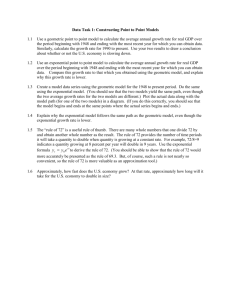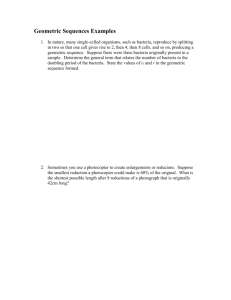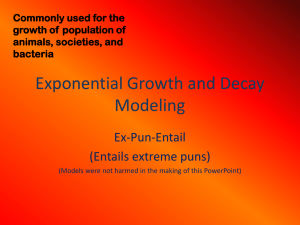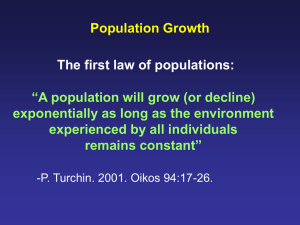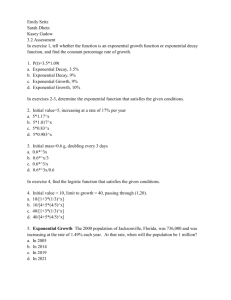Starter: What type of pattern is each (linear, quadratic or geometric)
advertisement
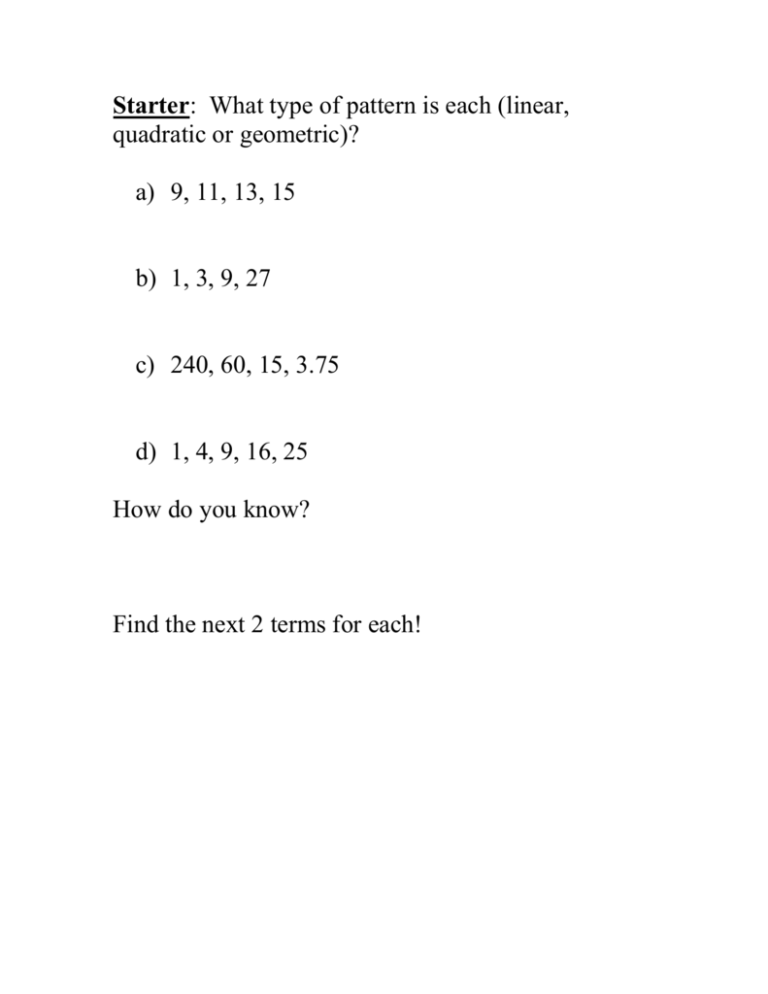
Starter: What type of pattern is each (linear,
quadratic or geometric)?
a) 9, 11, 13, 15
b) 1, 3, 9, 27
c) 240, 60, 15, 3.75
d) 1, 4, 9, 16, 25
How do you know?
Find the next 2 terms for each!
Exponential Growth: Unit 4
Portfolio 1: The Basics of Exponents
Where do we use it in real life???
1) carbon dating – archaeology
2) radioisotopes – medicine
3) decay of sales – advertising
4) finances – compound interest
5) population growth – statistics Canada
Pattern: Exponential Decay: 100, 50, 25, 12.5, …
Exponential Growth: 100, 300, 900, 2700, …
A geometric sequence is an exponential sequence.
These always have a ratio…
Decay: ÷
Growth: x
Equations: Have an “x” as an exponent.
Examples: y = 2x
General Equation: y = abx
y = 5x-3
where a is the initial value of y, i.e. a is what y is
when x = 0,
and b is the initial growth rate.
Graphs:
PROBLEM: When a piece of paper has been
folded in half 5 times, how many sections are
formed by the creases?
# of
folds
# of
sections
1
2
3
4
5
Describe the pattern:
Put the information into the TI 83 lists.
Find equation.
Using Stat Plot, sketch a graph of this
pattern. What is the shape of the graph?
Use the calculator to find the equation for
this pattern.
Use your equation to answer the following: If
you could fold a piece of paper 15 times, how
many sections would there be?
Y = 1 x 2^x
X = 15
Y = 1 x 2 ^15 = 32 768
What about 100 folds?
Y = 1 x 2 ^ 100 = 1.2676506 E 30
http://www.youtube.com/watch?v=kRAEBbotuIE
Page 100, Question 8
Colin hires a teenager to do some yard work for 15
days. He considers two options for payment:
Option 1: Colin will pay $30 per day of work.
Option 2: Colin will page $0.01 for the first day,
$0.03 for the second day, $0.09 for the third day and
so on.
a) Which option should the teenager choose?
Why?
b) Which option should the teenager choose if
they are working for 10 days?
Page 101, Question 9
John purchased a cottage property for $10 000.
The value of the property goes up by 5% each year.
After one year it is worth $10 500 and the next year
it is worth $11 025. The following sequence
represents the pattern:
{10 000, 10 500, 11 025, 11 576.25, …}
a) Is this a geometric sequence? Explain.
b) What is the next term, t5, in the sequence?
What does it represent?
Question 10
Chester purchased a second hand powerboat for
$10 000. The value of the boat decreases in value
by 5% each year. After one year it is worth $9500,
then the next year $9025. The following sequence
represents the pattern:
{10 000, 95000, 9025, 8573.75, …}
a) Is this a geometric sequence? Explain.
b) What is the next term, t5, in the sequence?
What does it represent?
c) When will the boat be worth $7737.81?
d) If the value of the boat went down by 8% each
year, what would be the common ratio between
the successive terms in the sequence?
11. a) The number of bacteria in a particular
population triples every 15 minutes. Suppose
the population was initially 100 bacteria.
Create a sequence to show how the population
of the bacteria changes every 15 minute.
(Note: t1 = 100)
b) Is the sequence in a) geometric? Explain.
c) What does the third term, t3, in the sequence
represent?
Complete question 12 page 101.
Complete question 13 to 16 on page 102
